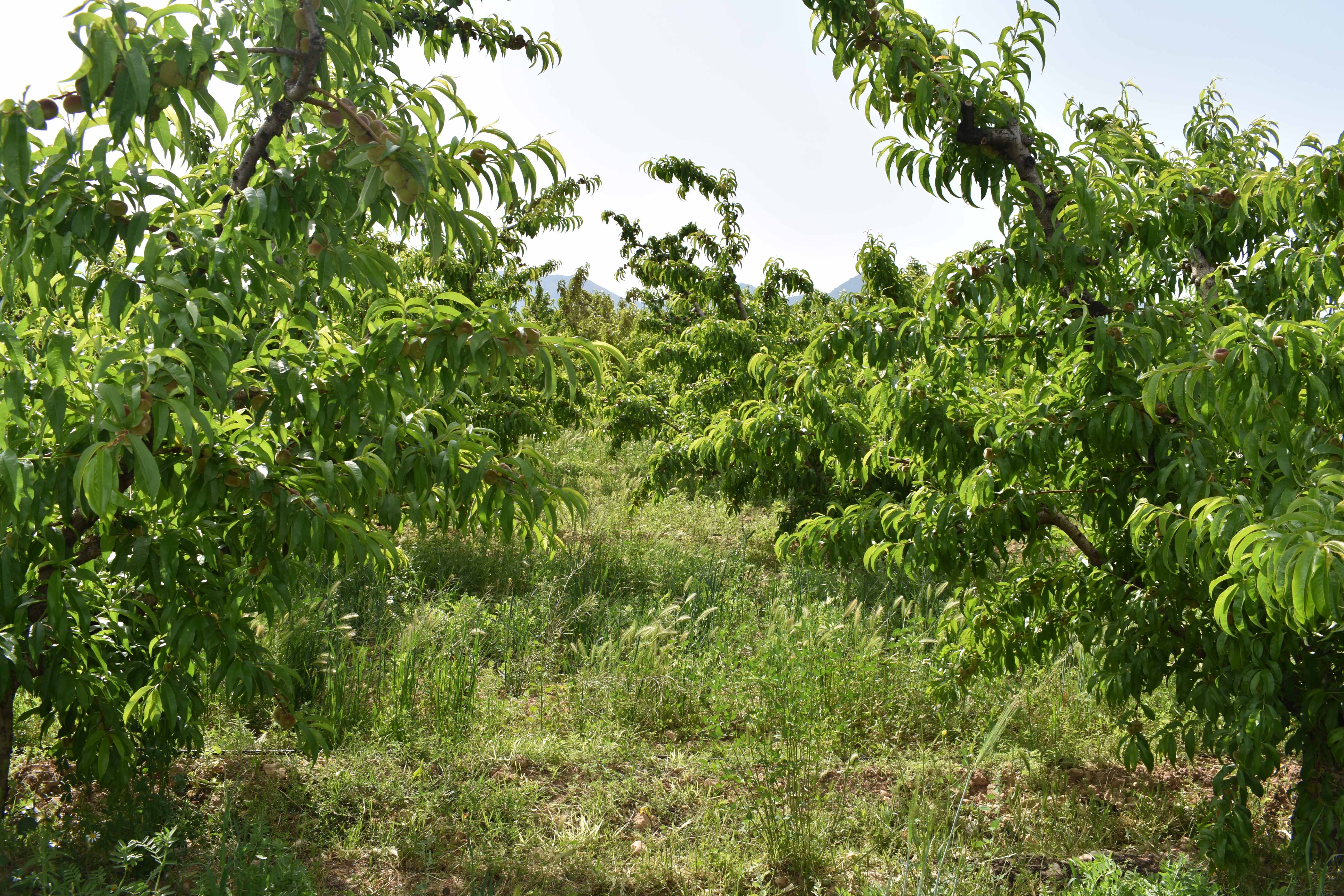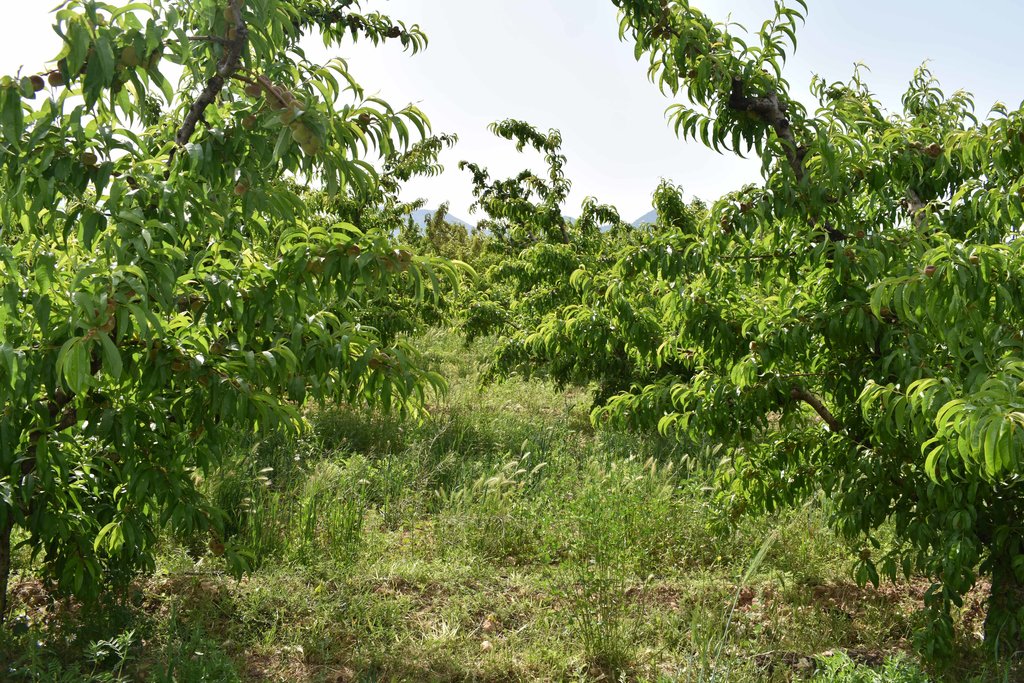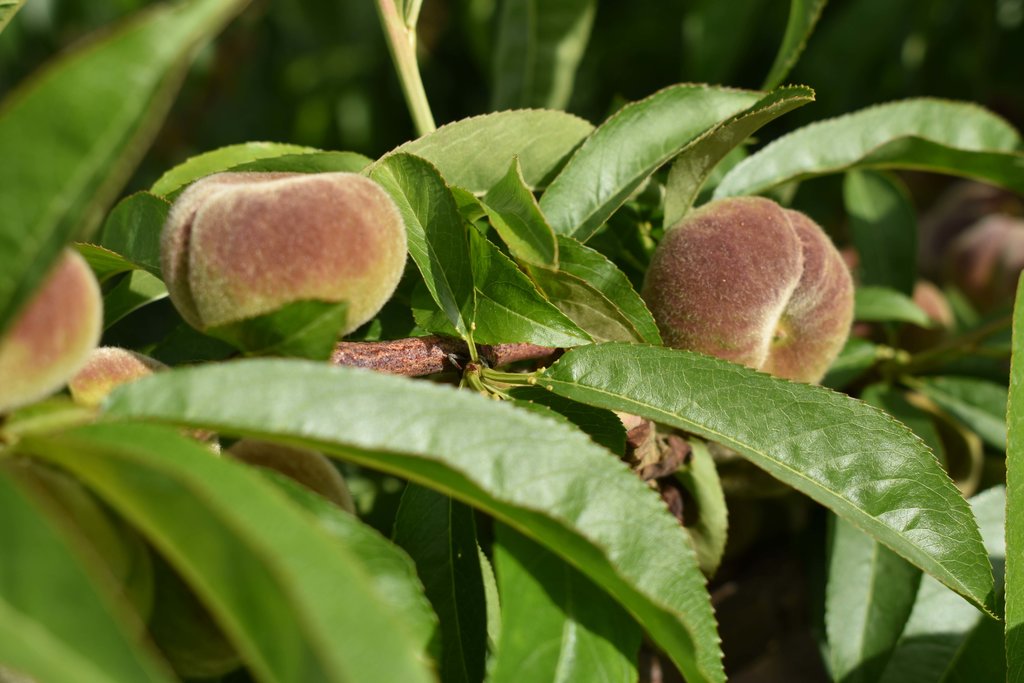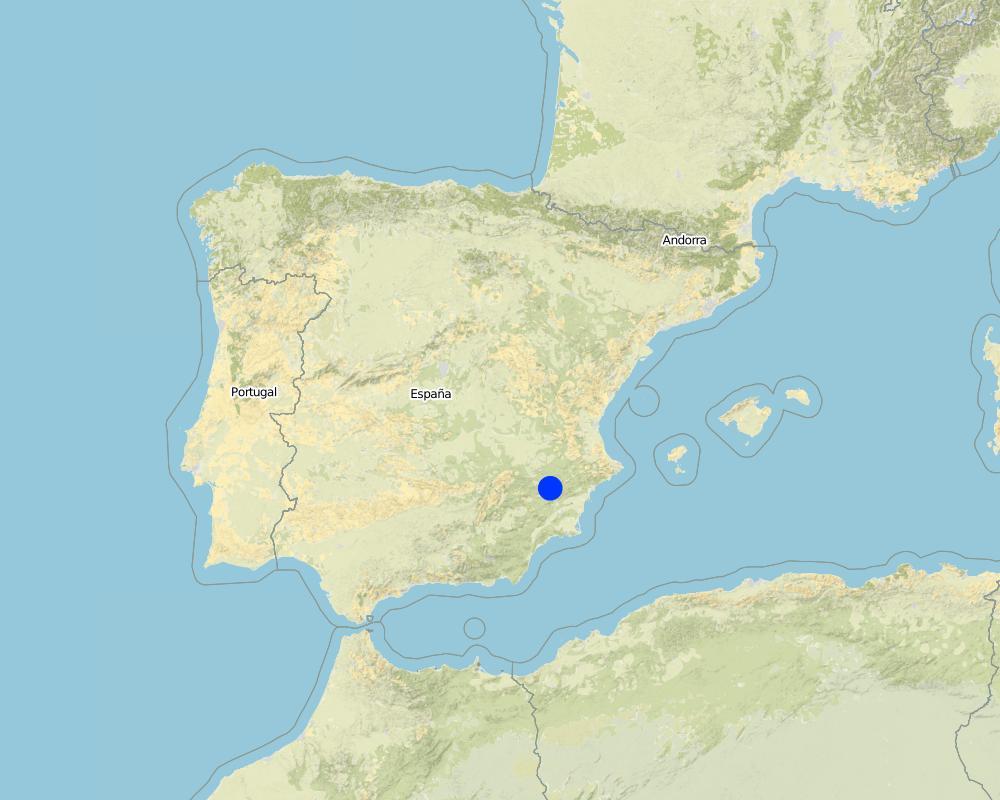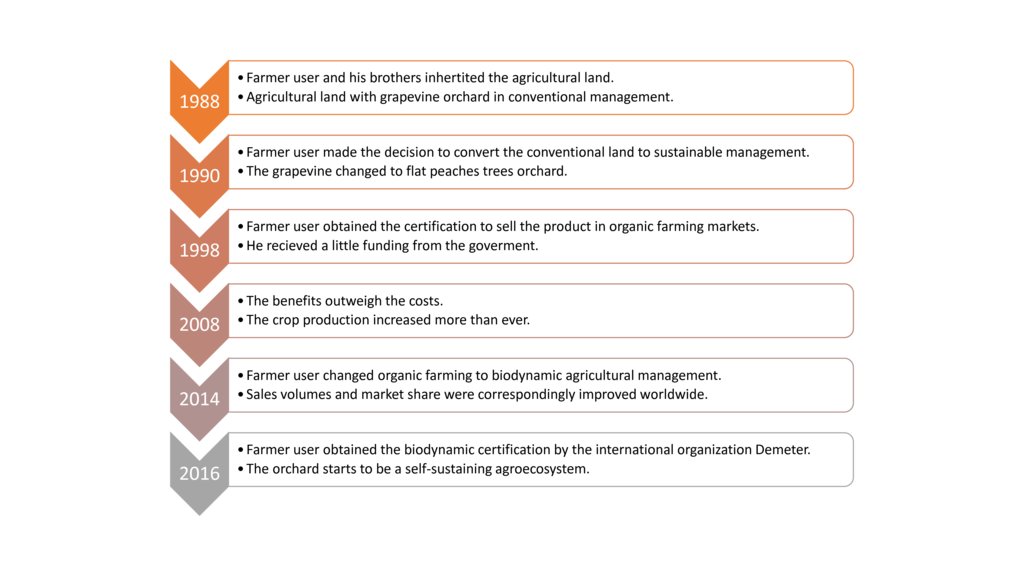Fruit trees under biodynamic agricultural management in southern Spain [Spain]
- Creation:
- Update:
- Compiler: Alicia Morugán-Coronado
- Editor: –
- Reviewers: Ursula Gaemperli, Gudrun Schwilch
Biodynamic agriculture in southern Spain
approaches_2689 - Spain
View sections
Expand all Collapse all1. General information
1.2 Contact details of resource persons and institutions involved in the assessment and documentation of the Approach
Key resource person(s)
land user:
Name of project which facilitated the documentation/ evaluation of the Approach (if relevant)
Interactive Soil Quality assessment in Europe and China for Agricultural productivity and Environmental Resilience (EU-iSQAPER)Name of the institution(s) which facilitated the documentation/ evaluation of the Approach (if relevant)
Agrochesmistry and Environment Department, University Miguel Hernandez (UMH) - Spain1.3 Conditions regarding the use of data documented through WOCAT
When were the data compiled (in the field)?
05/05/2017
The compiler and key resource person(s) accept the conditions regarding the use of data documented through WOCAT:
Ja
1.4 Reference(s) to Questionnaire(s) on SLM Technologies
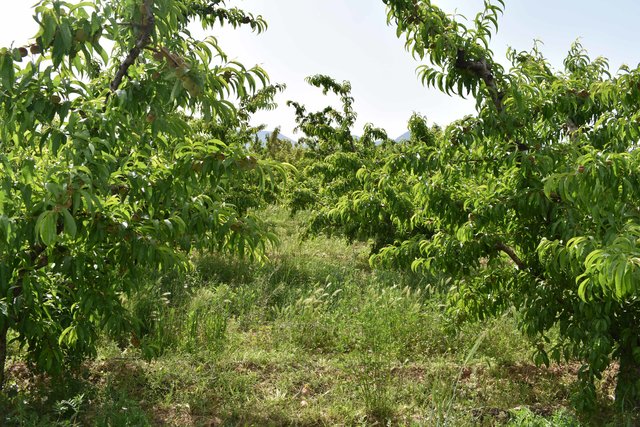
Preparation 500 application in agricultural soils under a … [Spain]
This technology is focused in the application of the preparation number 500 based on cow dung filled in cow horns, and buried in the soil pit during the cooler month to improve soil structure, soil nutrition and humus formation
- Compiler: Alicia Morugán-Coronado
2. Description of the SLM Approach
2.1 Short description of the Approach
Biodynamic farming is a method of farming that aims to treat the farm as a living system, based on the application of specific organic preparations which stimulate the natural functions of the farm soils and provide the necessary component towards a self-sustaining agro-ecological farm management.
2.2 Detailed description of the Approach
Detailed description of the Approach:
Biodynamic farming is a method of farming that aims to treat the farm as a living system, biodynamic farming consists of a holistic, ecological and ethical approach based on organic preparations towards the objective of soil as self-sustaining agro-ecosystem. The aim of Biodynamic fertility management is to generate a farm’s fertility from within the farming
system itself rather than importing inputs from the outside. This generally involves the recycling of raw organic materials generated on the farm with the goal of developing soil humus and the related biological activity that such a process ignites. A distinguishing feature of Biodynamic agriculture is the use of nine preparations made from herbs, mineral substances and animal manures that are utilized in field sprays and compost inoculants applied in minute doses, much like homeopathic remedies are for humans. Originally described by Rudolf Steiner in a series of lectures on agriculture, these Biodynamic preparations are numbered 500 – 508. Generally, this approach aims to establish biodynamic agricultural management in flat peaches orchards and keep environmental sustainability in Jumilla, Murcia region (Spain).
Its specific objectives:
(1) To enhance the biodynamic agricultural production in the region and worldwide.
(2) To improve the quality of soil and soil fertility.
(3) To develop the orchard to self-sustaining agro-ecosytem.
(4) To improve product quality and market opportunities.
(5) To obtain organic food consumer demand worldwide.
Stages of implementation:
(1) Inherited a conventional orchard and changing the agricultural management to more sustainable practices,
(2) Getting eco-labelling to sale organic food product in European markets,
(3) Constant improvement and maintenance practices to improve soil fertility and productivity,
(4) Changing to biodynamic agricultural land and obtain the certification to sell the product worldwide,
(5) and monitoring and evaluation including operation and maintenance.
Role of stakeholders:
Demeter (International organization in biodynamics agricultural management)
1. Orchard certification.
2. Provide technical support and assistance in biodynamic agricultural management maintenance.
Family organization
1.Support in orchard production
Miguel Hernandez University
1. Assessment in soil physical-chemical and biological properties.
Centro de Edafología y Biología Aplicada del Segura (CEBAS) research center
1. Soil quality evolution and innovative irrigation technics.
2.3 Photos of the Approach
2.4 Videos of the Approach
Comments, short description:
preparation 500 is basically fermented cow dung. It is the basis for soil fertility, and the renewal of degraded soils. Preparation 500 is made by filling a cow's horn with cow dung, and burying it in the soil during the cooler months - November through February. The horns should be buried open end down so that they will not become water logged if the pit is over watered.
During the cooler months life breathes into the soil and the soil has the tendency to be full of growth energies, which energies are absorbed into the dung through the receptive nature of the horn. The preparation when ready after 4 months should have turned into dark humus and should be sweet smelling. It is sprayed up to four times a year. The best times are in October and November and then again in February and March. It is important to apply in the late afternoon.
Date:
05/05/2017
Location:
Jumilla
Name of videographer:
Alicia Morugán Coronado
2.5 Country/ region/ locations where the Approach has been applied
Country:
Spain
Region/ State/ Province:
Murcia
Further specification of location:
Jumilla
Map
×2.6 Dates of initiation and termination of the Approach
Indicate year of initiation:
2014
2.7 Type of Approach
- recent local initiative/ innovative
2.8 Main aims/ objectives of the Approach
Achieve to a self-sustaining agro-ecosystem.
Improve the quality of soil.
Improve soil fertility.
To enhance in product quality.
To obtain organic food consumer demand worldwide.
2.9 Conditions enabling or hindering implementation of the Technology/ Technologies applied under the Approach
availability/ access to financial resources and services
- hindering
No financing and monetary help.
collaboration/ coordination of actors
- enabling
Consulting, counselling, formation, distribution, selling and advertisement of product.
policies
- enabling
Biodynamics agriculture regulation.
http://www.demeter.es/normativa
knowledge about SLM, access to technical support
- enabling
The international biodynamics association advice directly to farmer. (Demeter)
markets (to purchase inputs, sell products) and prices
- enabling
Sales guaranteed in 100%
workload, availability of manpower
- enabling
Decreasement in manpower
3. Participation and roles of stakeholders involved
3.1 Stakeholders involved in the Approach and their roles
- local land users/ local communities
Antonio García Vargas
Farm user and owner.
- community-based organizations
Family organization
Support as farm staff
- SLM specialists/ agricultural advisers
MST advisor
Advice in agricultural management and technical support in biodynamic preparations.
- researchers
centro de edafologia y biologia aplicada del segura (cebas) - CSIC
Agroquímica y Medio Ambiente - Universidad MIguel Hernandez
Soil quality evolution and innovative irrigation technics.
- international organization
Demeter advisors
Biodynamic agricultural management advice and evaluations
3.2 Involvement of local land users/ local communities in the different phases of the Approach
| Involvement of local land users/ local communities | Specify who was involved and describe activities | |
|---|---|---|
| initiation/ motivation | self-mobilization | http://www.frutasvargas.com/ The land user had the motivation to change his organic farming management to biodynamic. |
| planning | external support | The land user asked Demeter to receive specific recommendation to establish biodynamic agricultural management. |
| implementation | external support | The land user implemented the approach with the external support of Demeter in order to certified the biodynamic production. |
| monitoring/ evaluation | external support | Demeter, Miguel Hernandez university and CEBAS-CSIC help the land user to maintain the biodynamic production and evaluate the soil quality. |
3.3 Flow chart (if available)
3.4 Decision-making on the selection of SLM Technology/ Technologies
Specify who decided on the selection of the Technology/ Technologies to be implemented:
- mainly land users, supported by SLM specialists
Specify on what basis decisions were made:
- personal experience and opinions (undocumented)
4. Technical support, capacity building, and knowledge management
4.1 Capacity building/ training
Was training provided to land users/ other stakeholders?
Ja
Specify who was trained:
- field staff/ advisers
Form of training:
- farmer-to-farmer
- demonstration areas
Subjects covered:
University students groups visit the fruit orchard to learn about biodynamic agricultural management.
4.2 Advisory service
Do land users have access to an advisory service?
Ja
Specify whether advisory service is provided:
- on land users' fields
Describe/ comments:
Two times per year Demeter advisors visit the fruit orchard to evaluate the biodynamic agricultural management.
4.3 Institution strengthening (organizational development)
Have institutions been established or strengthened through the Approach?
- yes, greatly
Specify the level(s) at which institutions have been strengthened or established:
- regional
- national
Describe institution, roles and responsibilities, members, etc.
1ª FERIA DE AGRICULTURA BIODINAMICA DE ALBACETE (29 de abril de 2017)
4.4 Monitoring and evaluation
Is monitoring and evaluation part of the Approach?
Ja
Comments:
MST advisor
If yes, is this documentation intended to be used for monitoring and evaluation?
Nee
4.5 Research
Was research part of the Approach?
Ja
Specify topics:
- economics / marketing
- ecology
Give further details and indicate who did the research:
CEBAS-CSIC is a national research institution that used this biodynamic orchard to irrigation innovatives technologies.
http://www.cebas.csic.es/dep_spain/riego/riego_publi_2017.html
5. Financing and external material support
5.1 Annual budget for the SLM component of the Approach
If precise annual budget is not known, indicate range:
- 10,000-100,000
5.2 Financial/ material support provided to land users
Did land users receive financial/ material support for implementing the Technology/ Technologies?
Nee
5.3 Subsidies for specific inputs (including labour)
- none
If labour by land users was a substantial input, was it:
- paid in cash
5.4 Credit
Was credit provided under the Approach for SLM activities?
Ja
Specify conditions (interest rate, payback, etc.):
individual bank loan
Specify credit providers:
Bank
Specify credit receivers:
Frutas Vargas
5.5 Other incentives or instruments
Were other incentives or instruments used to promote implementation of SLM Technologies?
Nee
6. Impact analysis and concluding statements
6.1 Impacts of the Approach
Did the Approach empower local land users, improve stakeholder participation?
- No
- Yes, little
- Yes, moderately
- Yes, greatly
Implementation of innovative technologies in soil irrigation.
Did the Approach enable evidence-based decision-making?
- No
- Yes, little
- Yes, moderately
- Yes, greatly
Thanks to the approach the constant enhancement in the biodynamic management is doing.
Did the Approach help land users to implement and maintain SLM Technologies?
- No
- Yes, little
- Yes, moderately
- Yes, greatly
The approach facilitates the implementation and maintenance of SLM technology in order to increase the product quality.
Did the Approach improve coordination and cost-effective implementation of SLM?
- No
- Yes, little
- Yes, moderately
- Yes, greatly
Benefits were observe inmediately after of approach implementation.
Did the Approach improve knowledge and capacities of land users to implement SLM?
- No
- Yes, little
- Yes, moderately
- Yes, greatly
yes, the constant improvement and modifcations in the biodynamic agricultural management involve the land user in the increase of agricultural knowledge.
Did the Approach improve knowledge and capacities of other stakeholders?
- No
- Yes, little
- Yes, moderately
- Yes, greatly
Yes, the land user gives advice to other farmers.
Did the Approach build/ strengthen institutions, collaboration between stakeholders?
- No
- Yes, little
- Yes, moderately
- Yes, greatly
The approach facilitates the collaboration with several organization and research institutions.
Did the Approach lead to improved food security/ improved nutrition?
- No
- Yes, little
- Yes, moderately
- Yes, greatly
Yes, the approach is focused in improve the product quality following a biodynamic soil management
Did the Approach improve access to markets?
- No
- Yes, little
- Yes, moderately
- Yes, greatly
Yes, all the product is sold in regional, national and worldwide market.
Did the Approach lead to more sustainable use/ sources of energy?
- No
- Yes, little
- Yes, moderately
- Yes, greatly
Yes, the biodynamic soil and product management is the main objective of this approach.
Did the Approach lead to employment, income opportunities?
- No
- Yes, little
- Yes, moderately
- Yes, greatly
The approach lead to market opportunities.
6.2 Main motivation of land users to implement SLM
- increased profit(ability), improved cost-benefit-ratio
More price in the product.
- affiliation to movement/ project/ group/ networks
Biodynamic movement
- environmental consciousness
Biodynamic soil management improves the ecosystem.
6.3 Sustainability of Approach activities
Can the land users sustain what has been implemented through the Approach (without external support)?
- yes
If yes, describe how:
The farmer implement the approach with a great deal of difficulty, for example, money constraints as the certification is too expensive or other difficulties, the biodynamic preparations are difficult to apply and the Demeter certification is so expensive to maintain.
6.4 Strengths/ advantages of the Approach
| Strengths/ advantages/ opportunities in the land user’s view |
|---|
| Improvement in crop production and sales oportunities |
| Sustainable farming improves the plant function and response against plagues |
| greater social recognition and money income |
| Strengths/ advantages/ opportunities in the compiler’s or other key resource person’s view |
|---|
| Reduction of soil degradation |
| Enhancement of soil fertility |
6.5 Weaknesses/ disadvantages of the Approach and ways of overcoming them
| Weaknesses/ disadvantages/ risks in the land user’s view | How can they be overcome? |
|---|---|
| The implementation process requires a excessive investment of money | More production to overcome this costs. |
| Exhaustive training in biodynamic management to implement this practice | More practice in the biodynamic preparation is needed. |
| Exhaustive external control to be validate as biodynamic agricultural management | The land user make external links with research institutions in soil quality evolution. |
| Weaknesses/ disadvantages/ risks in the compiler’s or other key resource person’s view | How can they be overcome? |
|---|---|
| Short response times against weather problems |
7. References and links
7.1 Methods/ sources of information
- field visits, field surveys
2
- interviews with land users
1
- interviews with SLM specialists/ experts
2
7.2 References to available publications
Title, author, year, ISBN:
no
7.3 Links to relevant information which is available online
Title/ description:
Web page
URL:
http://www.frutasvargas.com/
Links and modules
Expand all Collapse allLinks

Preparation 500 application in agricultural soils under a … [Spain]
This technology is focused in the application of the preparation number 500 based on cow dung filled in cow horns, and buried in the soil pit during the cooler month to improve soil structure, soil nutrition and humus formation
- Compiler: Alicia Morugán-Coronado
Modules
No modules


